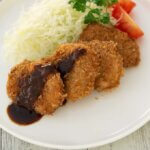
Crumbed Pork Tenderloin Medallion was made just like I made Tonkatsu and Chicken Cutlet, but the meat is so tender. The contrast between the tender meat and the crunchy golden-brown breadcrumbs is to die for. I am serving this with a unique miso sauce.
Cook time assumes that you fried pork medallions in two batches.
Don't forget to see the section 'MEAL IDEAS' below the recipe card! It gives you a list of dishes that I have already posted and this recipe that can make up a complete meal. I hope it is of help to you.
- About 450g/1lb pork tenderloin (note 1)
- ¼ tsp salt
- ¼ tsp pepper
- 2 tbsp flour
- 1 egg beaten
- 1-1¼ cup panko breadcrumbs (note 2)
- Oil to deep-fry
- 30g/1.1oz aka miso (red miso, note 3)
- 1 tbsp sugar
- 2 tbsp mirin
- 1 tbsp cooking sake
- 60ml/1fl oz dashi stock
- ¼ tsp corn flour/cornstarch diluted in ½ tsp water
- Shredded cabbage
- Sprigs of parsley
-
Put all the Miso Dare ingredients, excluding the corn flour/cornstarch, into a small saucepan and dilute the miso using a whisk.
-
Bring it to a boil at medium heat, occasionally stirring.
-
Add corn flouer/cornstarch to the pan and mix well. Remove the pan from the heat.
-
If your pork tenderloin has a silver skin (connective tissue) on it, remove it (, see the step-by-step photo) as it is chewy (note 4).
-
Starting from the thick end of the pork tenderloin, slice the meat diagonally at about a 45 degree angle (note 5). The width of each slice needs to be 2.5-3cm/1-1⅛”.
-
As you get to the tail-end of the fillet, you should make wider slices since the diameter of the fillet becomes smaller (note 6).
-
Place the sliced pork medallions on a cutting board without overlapping, and gently pound them with your fist. Pound harder for the medallions cut from the tail end of the meat, to make the thickness and the size of the medallion similar to others.
-
Sprinkle salt and pepper on both sides of pork medallions.
-
Place flour, egg and breadcrumbs on a shallow plate or in a bowl individually and line them up in this order. Place an additional clean plate or a small baking tray next to the breadcrumbs.
-
Working one medallion at a time, coat a medallion with flour, shake off excess flour, then place it in the egg and coat all over. Allow excess egg to drip, then transfer to the breadcrumbs.
-
Cover the entire medallion in breadcrumbs, making sure that a good layer of breadcrumbs is stuck to both sides. Repeat for the rest of the medallions.
-
Heat oil in a deep frying pan to 170-180°C/338-356°F. The depth of about 2-2.5cm/¾-1” is sufficient.
-
Gently place medallions into the oil, without overcrowding. Depending on the size of the pan, you may fry in 2-3 batches.
-
Fry for about 2-2.5 minutes or until the bottom side is browned. Flip the fillet with tongs or a pair of long bamboo chopsticks and cook for further 2 minutes until the other side is browned.
-
Transfer the cutlet onto a tray with a rack or lined with a couple of layers of paper towel to drain excess oil.
-
Place shredded cabbage on one side of a plate and a sprig of parsley next to it.
-
Place 4 crumbed medallions next to the cabbage.
-
Serve with the miso dare in a small container.
1. I bought a vacuum sealed whole pork tenderloin, which weighed 432g.
2. Although you will have leftovers, it is easier to crumb the meat if you have excess panko breadcrumbs.
3. I used red miso so that the miso dare stands out when poured over the brown piece of crumbed pork. But you can use brown miso or white miso. Sweet white miso such as Saikyo miso is not suited.
4. Place the tip of a sharp thin knife underneath the silver skin (between the silver skin and red meat) and slide the knife to scrape the silver skin off. If you point the blade slightly upwards while sliding, you can avoid the knife cutting into the red meat. You may also want to remove the very thin, almost transparent, membrane that partially covers the surface of the meat.
5. If your pork tenderloin is very thick (about 7-8cm/3" in diameter) you don't need to cut it diagonally. My tenderloin was only about 5cm/2" at the thickest part. By diagonally slicing, you will be able to make your medallion larger. If you want to make a larger medallion, tilt your knife further, i.e., the back of the knife gets closer to the cutting board.
6. The narrow part of the tenderloin meat needs to be cut thicker because the diameter of the meat is smaller. By pounding these harder in the subsequent step, you can make similar size medallions.
Depending on the size of your pork tenderloin, the number of medallions you get will be different. I got 12 medallions from my tenderloin.
7. Nutrition per serving. It assumes the amount of oil absorbed into the cutlet is 10% of the weight of the meat, and all of the flour, egg, breadcrumbs are used up (unlikely).
serving: 240g calories: 522kcal fat: 24g (31%) saturated fat: 3.8g (19%) trans fat: 0.2g polyunsaturated fat: 4.6g monounsaturated fat: 14g cholesterol: 160mg (53%) sodium: 694mg (30%) carbohydrates: 34g (12%) dietary fibre: 2g (7%) sugar: 5.4g protein: 39g vitamin D: 1mcg (4%) calcium: 88mg (7%) iron: 3.8mg (21%) potassium: 700mg (15%)